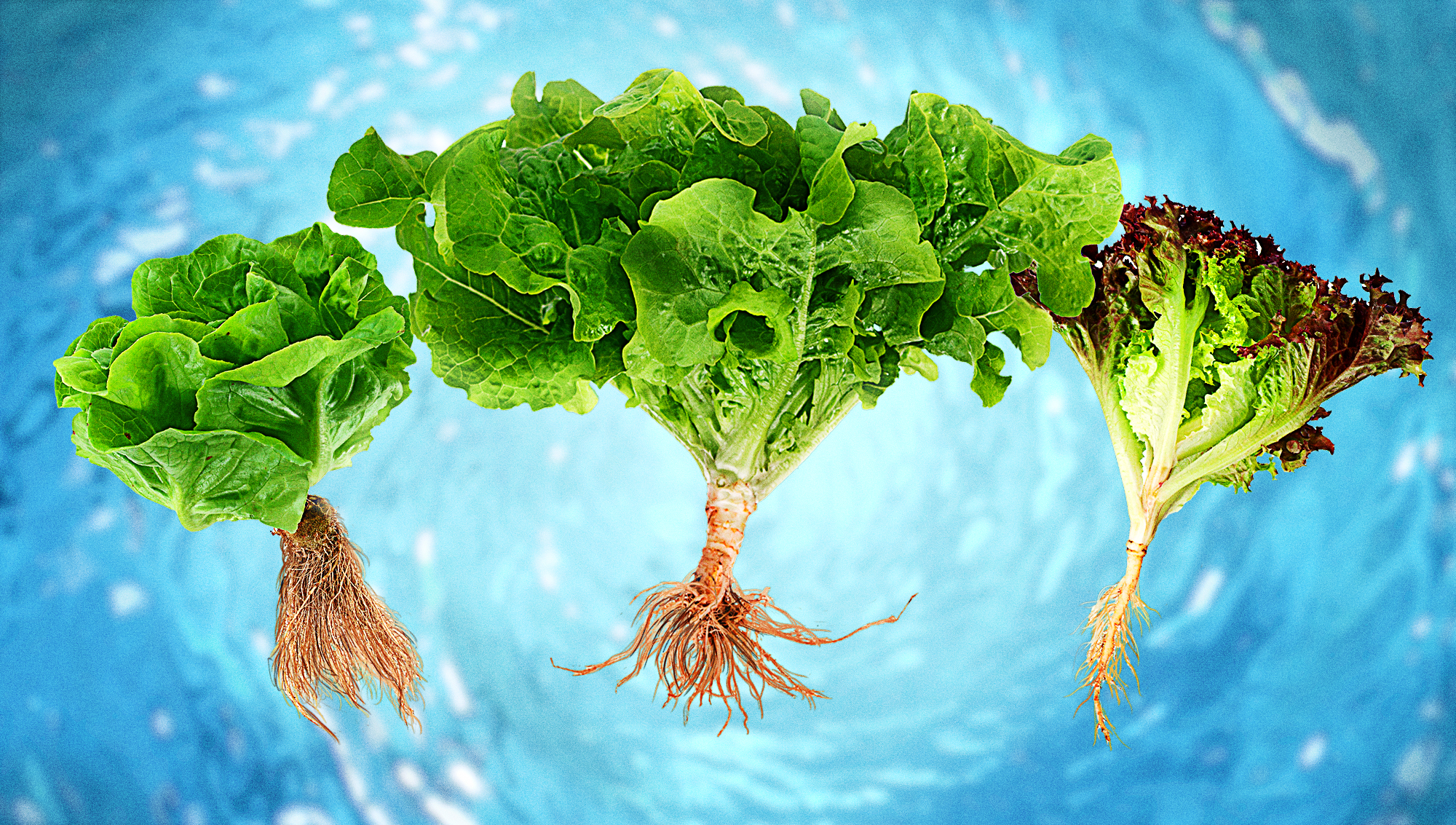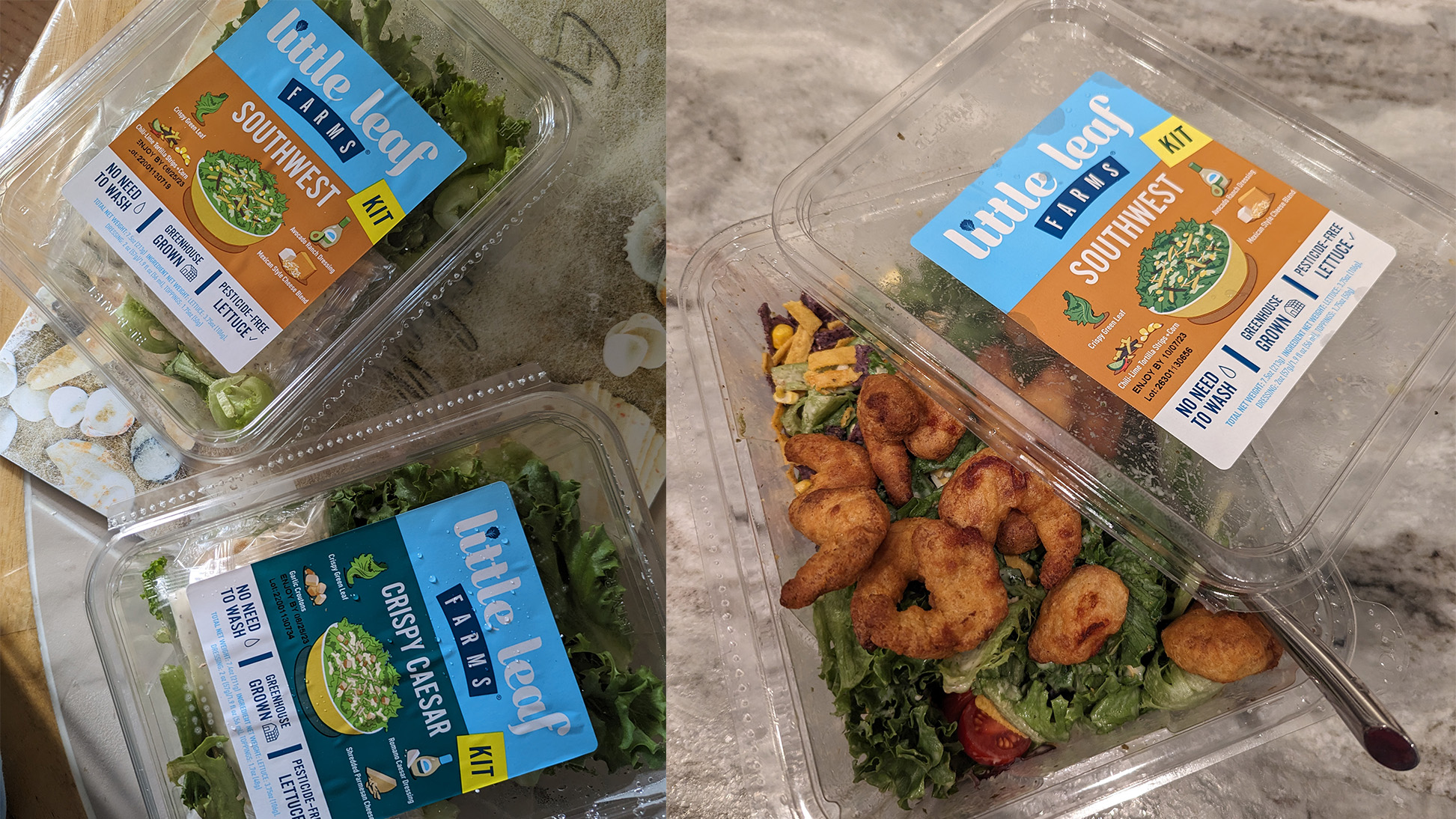A New Type Of Salad Is Taking Over The Grocery Store
Hydro greens have hit the streets in a big way. Here's what to know about hydroponic lettuce.
Composed big bowl salads are my bag. I'll try every one just to tell everyone how to build a better salad at Chopt, how to max out Fogo de Chao's salad bar, what's good at Sweetgreen, and so on. I love salad so much that sometimes when I travel and I'm feeling leaf-deprived, I'll buy a container of washed leafy greens just to eat straight up—and when I do, I prefer crisp, sweet, hydroponically grown baby greens.
So when I found out my favorite brand, Little Leaf Farms, was expanding into salad kits, I had to find out more. What I learned is these hydroponic salad greens are becoming more readily available as other regional brands like Revol Greens, Gotham Greens, and national leader in hydroponic produce BrightFarms are growing—in every literal sense—and jumping on the salad kit trend. Here's why you should be as excited about this news as I am.
What’s so special about hydroponically grown greens?
The first thing you'll notice is that these greens are crisp and sweet, far more so than your regular baby green salads. But they're also tender. After the initial crunch, there's a buttery richness to the leaves, particularly with softer lettuces like butterhead. They're super clean and fresh, since they're not grown out in fields but rather in enclosed greenhouses and most are shipped within 24 hours of harvest.
Paul Sellew, founder and CEO of Little Leaf Farms, tells us that hydroponic greens stay fresh longer because, requiring less space to grow, they're produced in local urban areas and therefore don't need to be hauled from California or Arizona, where over 90% of U.S. lettuces are grown. That means they can go from farm to table much faster.
Okay, cool, but what is hydroponic growing?
We've all heard of hydro in terms of weed, right? (Don't front; we know you know.) It's stronger and more potent, and that's because it's grown hydroponically, meaning in water, without soil, and within the principles of controlled environment agriculture (or CEA). This is a fancy way to say the plants are grown indoors with a lot of exact science, leaving very little to chance and allowing for year-round growing. Now apply that to lettuce, and you've got hydro greens.
"We grow in a peat moss and wood fiber substrate and 'fertigate' our plants with a nutrient and water solution ... producing a more nutritious leafy green," says Sellew.
Viraj Puri, co-founder and CEO of Gotham Greens, shares that the company's climate-controlled greenhouse hydroponic growing system "uses a growing technique by which plants receive a constant stream of recycled irrigation water enriched with a mineral nutrient solution, which they soak up through their root system." The two companies employ similar, but not identical, methods.
Why is hydroponic lettuce getting more popular?
As consumers get more eco-conscious and growers find more opportunities to maximize high-quality yield, CEA growing for leafy greens makes sense and cents, especially with recent technological developments.
Puri relies on advanced tech to create high yield and perfect crops all year round. "We have sensors located throughout the greenhouse that are very sophisticated and measure things such as temperature, humidity, carbon dioxide, oxygen, and light levels," he says. "All that information is fed through a computer control system that we've programmed to turn equipment on and off to attain our desired conditions." Predictably happy plants are the name of the game.
This kind of agriculture is also good for our communities. For Sellew, it's personal. "I come from a family of farmers and grew up helping with my family's nursery business, Prides Corner Farms," he says. As he pursued a career in agriculture, he found himself shocked by how far leafy greens had to travel to make it to his neck of the woods in Connecticut—all the way from the West Coast.
"This led me to start Little Leaf Farms in 2015 with a goal of transforming the way we grow our food and building a more resilient food system in New England," he says, since only 10% of the area's food is actually produced there. "By building our state-of-the-art greenhouses on the perimeter of major cities, we're taking those regions back to their roots so that they can once again start to feed local communities."
Puri had a similar "a-ha!" moment. "In our early business planning days, [co-founder and CFO] Eric Haley and I were having dinner in NYC and were surprised to learn the basil on our pasta had been flown halfway around the world from Israel," he says.
Further investigation led Puri to the same epiphany as Sellew, that "after traveling thousands of miles east [from California and Arizona], leafy greens and delicate herbs like basil were at least a week old and significantly contributing to carbon emissions and food waste. That's when we knew that there was a clear need and purpose for building farms closer to where people live all over the U.S."
Thus was born a national network of greenhouses that service cities close by, whether from a roof of an industrial warehouse or the company's new state-of-the-art flagship facilities just outside Atlanta.
Why are hydroponic greens better for the environment?
"Since we are capturing all our irrigation water for reuse, we are very water efficient using up to 90% less water and 97% less land than traditional soil-based agriculture," Puri says. "Gotham Greens' unique irrigation techniques use less than a gallon of water to grow a head of lettuce compared with up to 10 gallons used in conventional open-field farming,"
This is an important metric, since commercial agriculture is the largest use of both land and fresh water. It's also the leading cause of water pollution, due to the necessity of using chemicals and creating runoff.
Gathering and recycling naturally occurring water is a common theme among all of the growers we talked to. Little Leaf Farms is able to capture rainwater and uses something called Nutrient Film Technique with mobile gutters to recycle fertigation water. UV lights are then used to disinfect it, which means nothing foreign is introduced to it.
Jess Dillon, Director of Marketing for Revol Greens, tells us that the company goes a step further beyond just rain. "In our Minnesota and Texas greenhouses, we're able to capture rainwater and snowmelt in retention ponds," she says. "When needed, we bring that water into our facility and the first thing we do is UV sterilize it to rid it of any potential contaminants. Because we're using UV sterilization, this is a chemical-free process. And once the water is in our facility, we recycle and reuse it ... the only way it leaves is in our plants."
Puri notes that while vertical farming operations rely on artificial lighting, Gotham Greens makes use of natural sunlight—a cost and energy savings with the added benefit of higher quality produce.
Are hydroponic greens better for our health?
In a nutshell, yes, hydroponic greens are healthier, because smart CEA fully eliminates the use of chemical pesticides, herbicides, and fungicides.
"Growing indoors gives us control over what comes into our greenhouses and what our plants are exposed to," Puri explains. "We employ a comprehensive integrated pest management system that runs the gamut from environmental controls, environmental practices and a lot of cleaning and sanitation."
One thing that is allowed into the greenhouses? Bugs. More specifically, "beneficial insects," as Puri calls them; these are predatory bugs like ladybugs, which can prey on other insects that might threaten the produce.
"And our hydroponic greenhouses do not have any weeds, which eliminates the need for herbicides," he says.
Dillon also notes that being able to keep the circle small ensures better product. "Our greens are not exposed to outside contaminants or pests because we do everything—seed, grow, harvest, and pack within a singular facility."
Sellew goes even further. At Little Leaf Farms, the greenhouses are fully automated and integrate hands-free growing systems so that the leafy greens are never touched by human hands. Thanks to this, the greens are safe to consume straight from the container, which is perfect for on-the-go leaf snackers like me.
But how eco-friendly is all that plastic packaging?
One of the hallmarks of hydroponically grown greens is firm, clear plastic packaging. Personally, I've often felt bad about buying what seemed like wastefully produced clamshell containers versus a plastic bag that simply took up less landfill space. These mindful growers have considered that, too.
The reason plastic bags aren't an option for hydro greens is that the delicacy of the baby greens must be protected. It's a trade-off between more material use but less food waste.
"By packaging our greens in a rigid container, the lettuce is protected from being crushed in transit or in your refrigerator, which helps prevent spoiling," Sellew says. "It also allows for airflow to keep them fresher for longer."
While Little Leaf Farms is open to exploring other packaging options, currently it uses widely recyclable PET plastic clamshells, where "any excess plastic is saved and recycled," creating a closed loop that excludes landfills. Revol Greens follows the same formula.
Gotham Greens' California, Colorado, Georgia, and Texas greenhouses have rethought the lids on their tubs. Instead of a rigid plastic top, the new packaging has a layer of film on top that can be resealed between uses, cutting down down on overall plastic use. "We are currently working toward a goal of reducing plastic packaging for our leafy greens and herbs by 40% in 2024 and 80% by 2030," Puri says.
Hydroponic salad kits, explained
"Salad kits satisfy a different need state: consumers short on time seeking convenience," Dillon says, noting that the salad kit business is growing much faster than the salad category as a whole. Revol Greens Salad Kits were launched in late 2021 in four varieties: Green(house) Caesar, Southwest Baja, Sesame Ginger, and Sweet Poppyseed.
"We are always keeping an eye on trending flavors to ensure we are providing consumers what they want," Dillon adds.
In October, BrightFarms dropped a robust Mediterranean flavor with feta, roasted lentils, and herbed flatbread and Southwest Chipotle with fire-roasted corn, cotija cheese, and tortilla strips. Little Leaf Farms debuted its first two varieties only recently: Caesar with baby crispy Green Leaf, garlic croutons, and plenty of cheese; and Southwest, with chili-lime tortilla strips, corn, and avocado ranch. Sellew promises we'll be seeing more variety and distribution in the near future, which I'm excited for, since this is what led me down this rabbit hole to begin with.
But closer to my current home in Atlanta, Gotham Greens just rolled out Green Goddess, a bright herby mix with pepitas, cranberries, and puffed quinoa; Southwest Ranch with jalapeno ranch dressing and chili-lime tortilla strips; and Caesar with shaved (not shredded) cheese and crumbled herb focaccia croutons.
These kits, as Dillon points out, "create a fuller plate," which makes them satisfying to behold before you dig into giant forkfuls of whole leaves. And just like that, it's become a whole lot easier to eat your greens.

